The Qualcomm Snapdragon 835 Performance Preview
by Matt Humrick & Ryan Smith on March 22, 2017 4:30 AM EST- Posted in
- Smartphones
- Snapdragon
- Qualcomm
- Mobile
- SoCs
- Snapdragon 835
- Kryo
GPU Performance
Snapdragon 835’s updated Adreno 540 GPU shares the same basic architecture as Snapdragon 820’s Adreno 530, but receives some optimizations to remove bottlenecks along with some tweaks to its ALUs and register file. The Adreno 540 also reduces the amount of work done per pixel by using improved depth rejection, which could further improve performance and reduce power consumption.
Qualcomm is claiming a general 25% increase in 3D rendering performance relative to the Adreno 530 in S820. While not officially confirmed, it appears that Qualcomm is using the move to 10nm to increase peak GPU frequency to 710MHz, a roughly 14% increase over S820’s peak operating point, which would account for a significant chunk of the claimed performance boost.
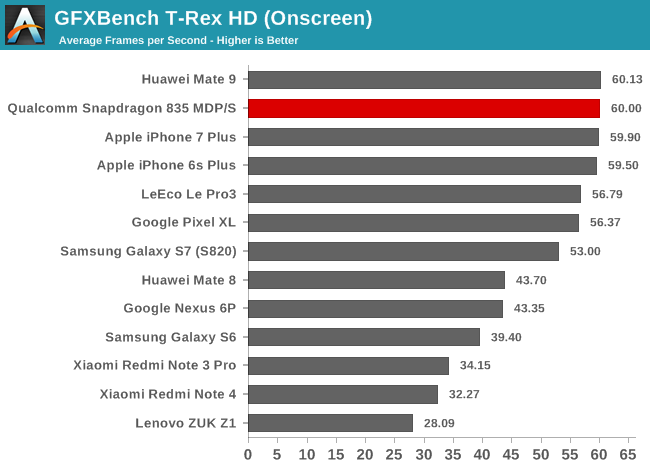
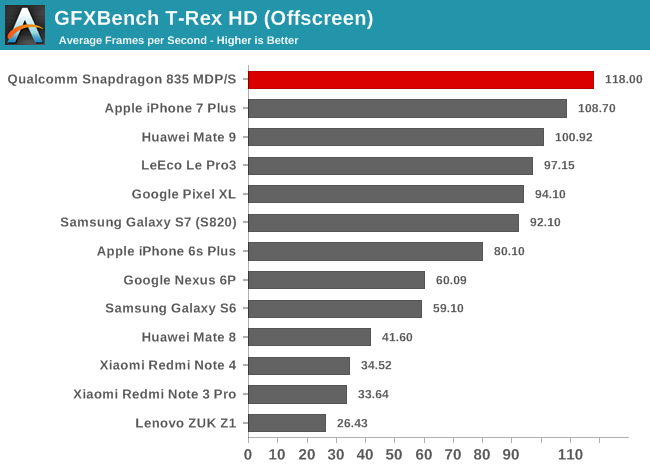
GFXBench T-Rex is an older OpenGL ES 2.0-based game simulation that’s not strictly limited by shader performance like the newer tests, which is one reason why flagship phones have been hitting the 60fps V-Sync limit for awhile now in the onscreen portion of the test. More recently, we’ve seen the iPhone 7 Plus and Mate 9, which both have 1080p displays, average 60fps over the duration of the test. Now the Snapdragon 835 MDP/S becomes the first 1440p device to reach this milestone.
The Snapdragon 835 MDP/S outperforms the iPhone 7 Plus and Mate 9 when running offscreen at a fixed 1080p resolution. It’s also 25% faster than the Pixel XL, the highest performing Snapdragon 820 phone, exactly matching Qualcomm’s performance claim. Sliding a little further back along Adreno’s roadmap shows the Adreno 540 with almost a 2x advantage over the Nexus 6P’s Adreno 430 and a 4.5x advantage over the ZUK Z1’s Adreno 330.
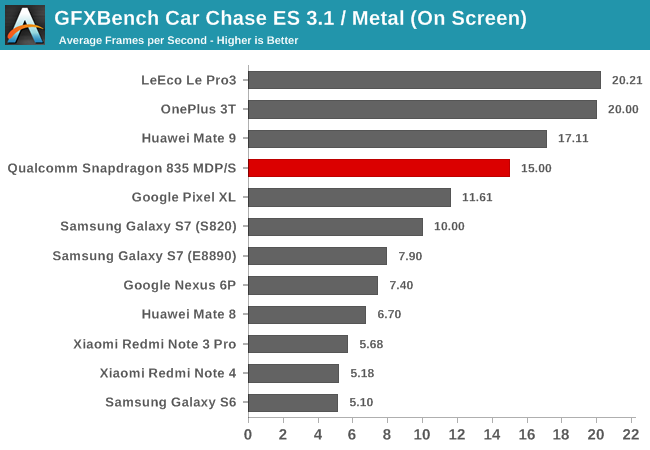
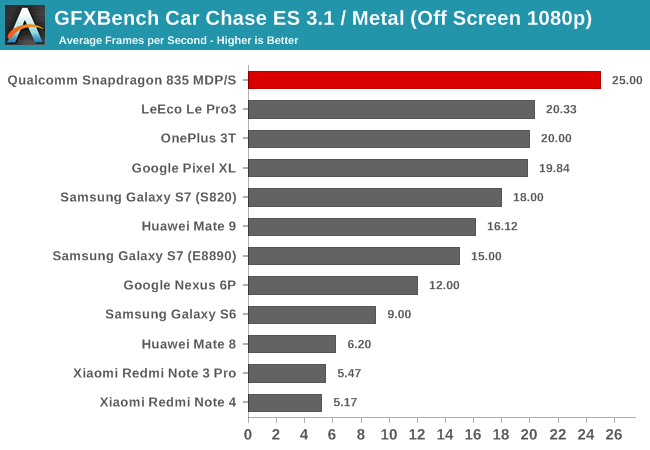
The GFXBench Car Chase game simulation uses a modern rendering pipeline with the latest features found in OpenGL ES 3.1 plus Android Extension Pack (AEP), including tessellation. Like many current games, it stresses ALU performance to deliver advanced effects.
Lower resolution 1080p displays paired with modern GPUs elevate the LeEco Le Pro3 (S821), OnePlus 3T (S820), and Huawei Mate 9 (Kirin 960) to the top of the chart in the onscreen portion of the test. The Snapdragon 835 MDP/S is the fastest 1440p device, besting the second-place Pixel XL by 29%.
Moving to the offscreen test shows the Adreno 540 GPU with a 25% lead over the Adreno 530 in S820. I do not usually put too much stock in performance claims on marketing slides, but so far Qualcomm’s claim is surprisingly accurate. Even more impressive is its 55% lead over the Mate 9’s Mali-G71MP8 GPU, which is based on ARM’s latest Bifrost microarchitecture and is running at 960MHz to 1037MHz during this test.
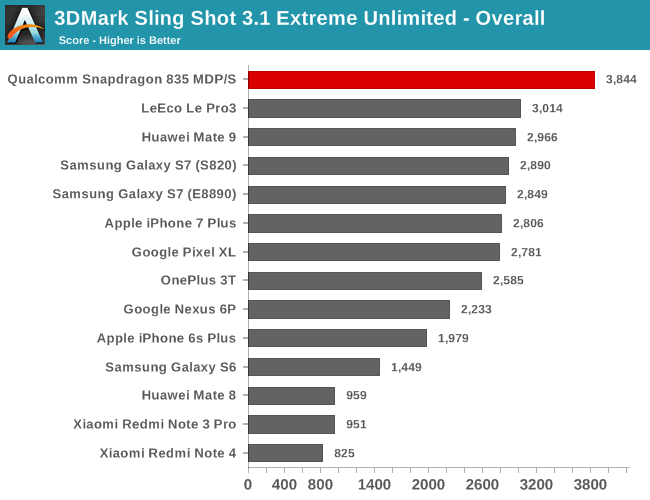


3DMark Sling Shot Extreme uses either OpenGL ES 3.1 on Android or Metal on iOS and stresses the GPU and memory system by rendering offscreen at 1440p (instead of 1080p like our other tests).
The Snapdragon 835’s 30% better overall score is pretty significant, considering that there’s only an 8% difference between all the phones using the Apple A10, Exynos 8890, Kirin 960, and S820/S821 SoCs. Diving into the graphics segment shows the Snapdragon 835 MDP/S outperforming the iPhone 7 Plus by 10% and both the S820 and Exynos 8890 versions of the Galaxy S7 by 24%.
Unlike the Adreno 530, which saw a significant uplift in geometry processing from changes to its microarchitecture, it does not appear that any additional changes were made to Adreno 540 based on its similar performance in 3DMark Sling Shot’s first graphics test. ARM’s Mali GPUs have done comparatively well in geometry processing tasks in the past, and in the first graphics test the Adreno 540 is only 11% faster than the Mate 9’s Mali-G71 GPU.
It’s in the second graphics test, which emphasizes shader performance, where we see the biggest gains from Adreno 540, with a 34% lead over the Galaxy S7’s Adreno 530 and a 50% lead over the Mate 9’s Mali-G71. Qualcomm’s changes to its ALUs and register file seem to pay dividends here.
The Physics test runs on the CPU and is heavily influenced by how well an SoC’s memory controllers handle random access patterns. The Snapdragon 835 MDP/S finishes ahead of the Mate 9 by 14% despite their similar CPU performance. The S835’s memory controllers deliver lower latency and higher bandwidth than Kirin 960’s, which could explain its better result in this test.
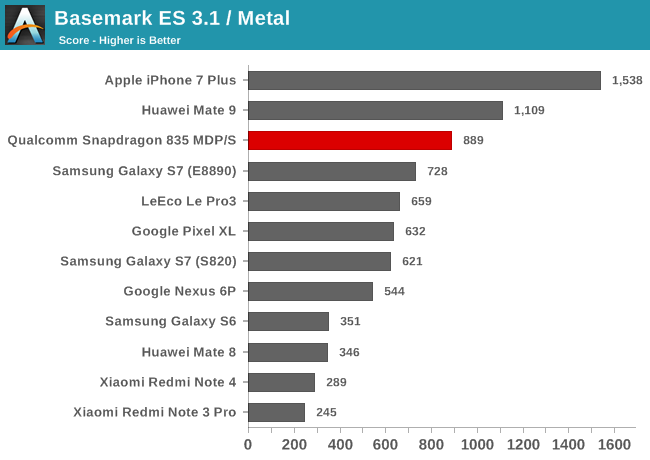
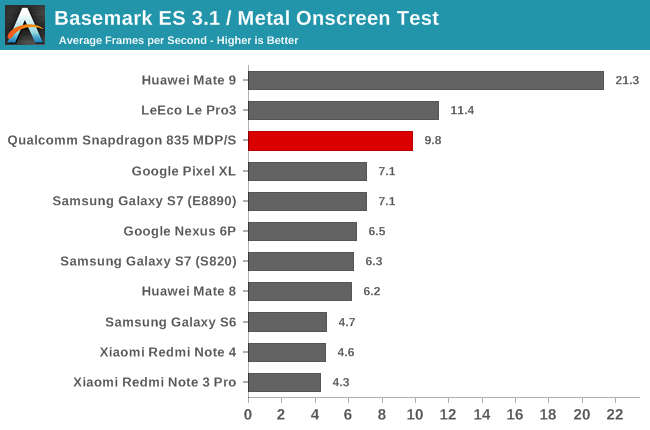

The Basemark ES 3.1 game simulation uses either OpenGL ES 3.1 on Android or Metal on iOS. It includes a number of post-processing, particle, and lighting effects, but does not include tessellation like GFXBench 4.0 Car Chase.
Until Vulkan support is added to benchmarks later this year, Android devices will continue to rely on OpenGL, putting them at a huge disadvantage to iPhones running Apple’s Metal graphics API, which dramatically reduces driver overhead when issuing draw calls. In this particular test, Metal helps push the iPhone 7 Plus in front of the Snapdragon 835 MDP/S by 73%.
ARM’s Mali GPUs perform better than their Adreno counterparts when running Basemark ES 3.1’s workloads; the Exynos 8890’s Mali-T880MP12 is 15% faster than S820’s Adreno 530 and Kirin 960’s Mali-G71MP8 is 25% faster than S835’s Adreno 540 in the offscreen test. The Snapdragon 835 MDP/S does perform 40% faster than the S820 in the Pixel XL, which is quite a bit more than the 25% gain it sees in our other tests.

The common theme in all of the game simulation tests is the Adreno 540’s better ALU performance, so I thought it would be interesting to see how well it performs in GFXBench’s synthetic ALU test. Surprisingly, its microarchitecture improvements are of no help here. The S835’s 14% advantage over the S820 and 8% advantage over the S821 exactly mirror their differences GPU frequency, assuming 710MHz for S835, suggesting this workload is bottlenecked elsewhere. It still manages to outperform the Mate 9’s Kirin 960 by 32%, however.










128 Comments
View All Comments
yankeeDDL - Wednesday, March 22, 2017 - link
In most of the graphs where the iPhone is present, they trounce anything else. It is quite disappointing, being an Android enthusiast, to see that the 835 does not catch up with a 6 month old phone...shing3232 - Wednesday, March 22, 2017 - link
but the bright side is that huge reduction in Power usage compare to 820ddriver - Wednesday, March 22, 2017 - link
This is comparing apples to oranges. Unless the two CPUs run the same code, performance is irrelevant.The web is majorly a shitpile of bloat, ridden with inefficiency. Apple simply invested more time into optimizing their web / JS implementation. This is not really indicative of CPU performance, only of web implementation optimizations.
And while it is true that apple's single threaded performance has been better, that is only a part of the story. You have the budget of n amount of transistors to put into x amount of total performance. If you have more threads, then obviously individual threads will be slower. Optimizing for low count threads is actually a pretty good idea given the typical mobile device usage patterns.
Why do most ARM chipmakers push for higher core count is a mystery to me. That is a STUPID strategy. It makes it that much harder to squeeze the most of your hardware.
I've been running proprietary software on phones and tables since 2012, software designed to scale adequately, and as a result, I see better overall performance from flagship android devices despite apple's better ST performance, but only because of the kind of workloads I am running. So while the chips aren't anywhere nearly as slow as AT's lame benchmarking suite would suggest, it is not exactly straightforward to get the max of their performance.
Lastly, the is this thing called "fast enough". Even if apple chips are traditionally faster in typical mobile applications than those found in android devices, this is not really an issue if the slower devices are still fast enough. I haven't really seen bottlenecks in the few 3rd party android apps I am using, so even with software that has not been designed to make use of many cores, things still run fast enough to not present an issue in regards with user experience.
All in all, in general I'd say ARM is not really trying to make things good, at least not as far as the user is concerned. The only reason apple invest into tangibly improving on the stock ARM designs is for the hype factor, rather than actually putting that performance into productivity. Mobile platforms are doubly limited just to make sure they don't revolutionize computing, both in terms of hardware, and available software. Pretty much next to useless toys, intended to use you far more than you use them, unless you have the resources to put into developing proprietary software tailored to your productivity needs.
close - Thursday, March 23, 2017 - link
Apple has yet another advantage. Since it controls its ecosystem end to end it can optimize the software for their specific hardware. In the Android ecosystem you have configurations ranging from 1 to 10 cores (or more?), so many different generations, so many different custom and semi-custom cores. A little trickier to optimize. So Android OEMs go for the numbers. Core numbers that is. Now with 25% more cores.And lets not forget another aspect. Historically Apple focused on optimizing the SoC layout for performance which led to much bigger cores which doesn't seem to be the method of choice in the Android ecosystem. They worked on improving the density, especially with the A8 and the A10.
ericgl21 - Wednesday, March 22, 2017 - link
Yep...iPhone's A10 Fusion chip is very capable indeed. And in September they're probably going to announce a better one (maybe called "A11"). Looks like Apple is ahead of everyone else, especially when it comes to web-related speeds.Samip - Wednesday, March 22, 2017 - link
Did you not read the disclaimer right below the web benchmarks?joms_us - Wednesday, March 22, 2017 - link
Guess what? I have never seen any comparison between iPhone 7 and flagship Android phone with SD821 where iPhone 7 is faster in app and browsing site. These benchmarks mean nothing if you are using different platforms particularly OS.Check out this comparison
https://youtu.be/mcTAXsFHu5I
gigathlete - Wednesday, March 22, 2017 - link
Check out this comparison: https://www.youtube.com/watch?v=vm8zC2VAr8wjoms_us - Wednesday, March 22, 2017 - link
Bwaha PhoneBluff. Who launches 10 apps in a minute and close it right away with the home button? Retards?His finger is faster on the home button of iPhone than OP3T =D
TadzioPazur - Wednesday, March 22, 2017 - link
This "test" is broken. Instead of measuring each activity individually, the test mashes them all together and measures total time. This makes no sense whatsoever - users are interested in doing one thing at a time, so individual tests somehow reflect perceived speed of the device.Measuring all together is not how we use these kind of devices. Especially that a lot of those activities reflect the mass storage sequential read. So all PhoneBuff needed to have done to show his beloved device was the fastest, was to put enough application load activities and leverage faster IO.
So I do think this "test" is so much worse than the above, posted by @joms_us.